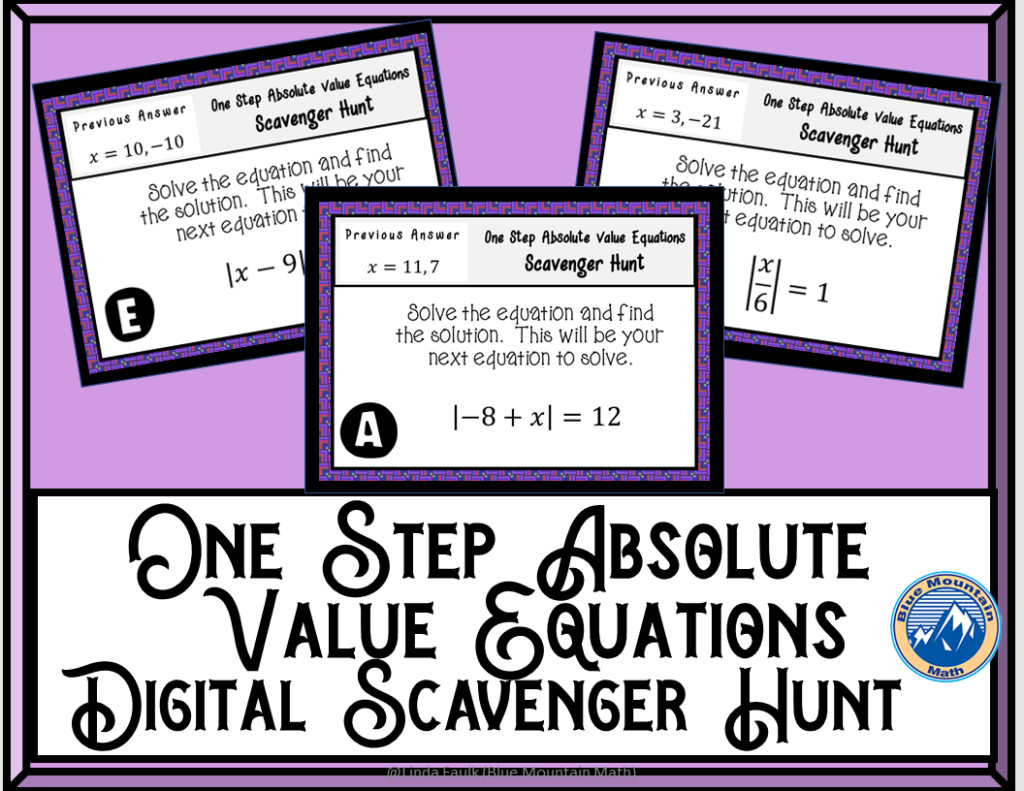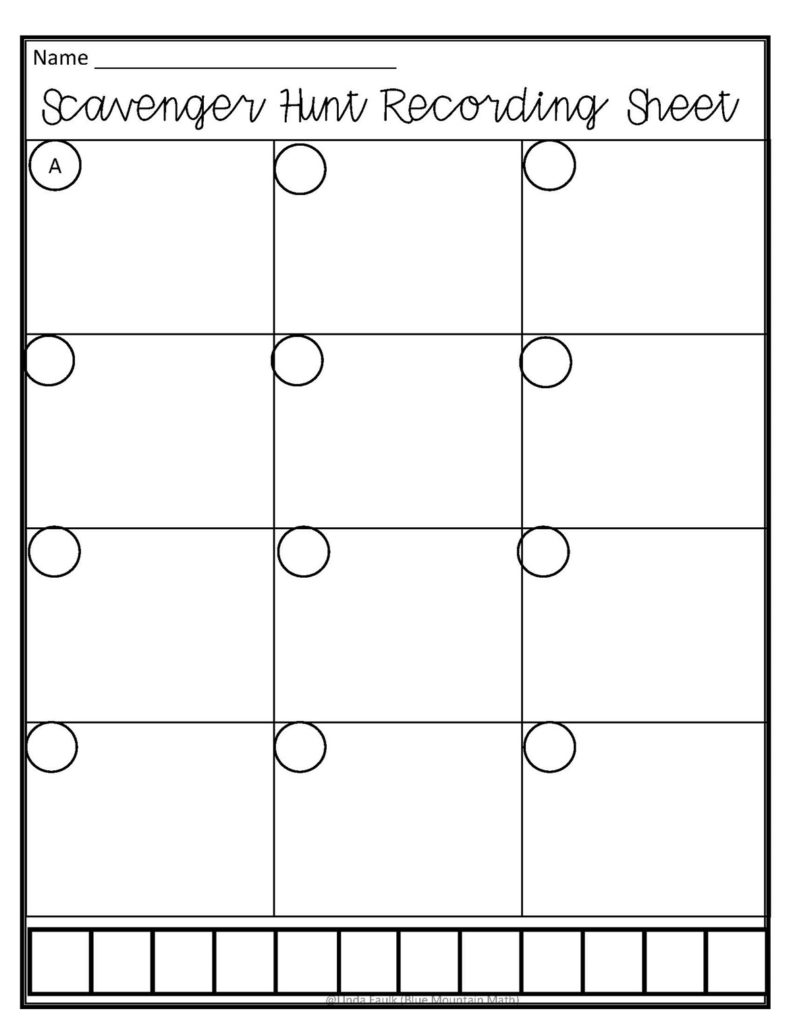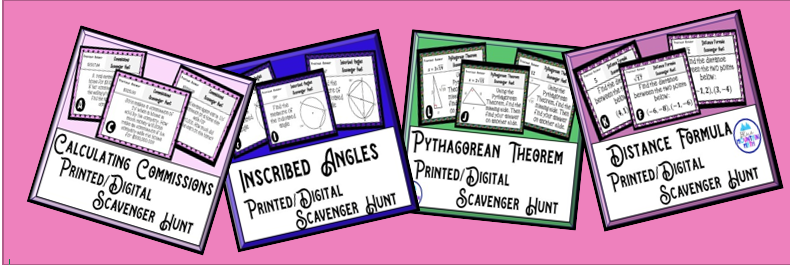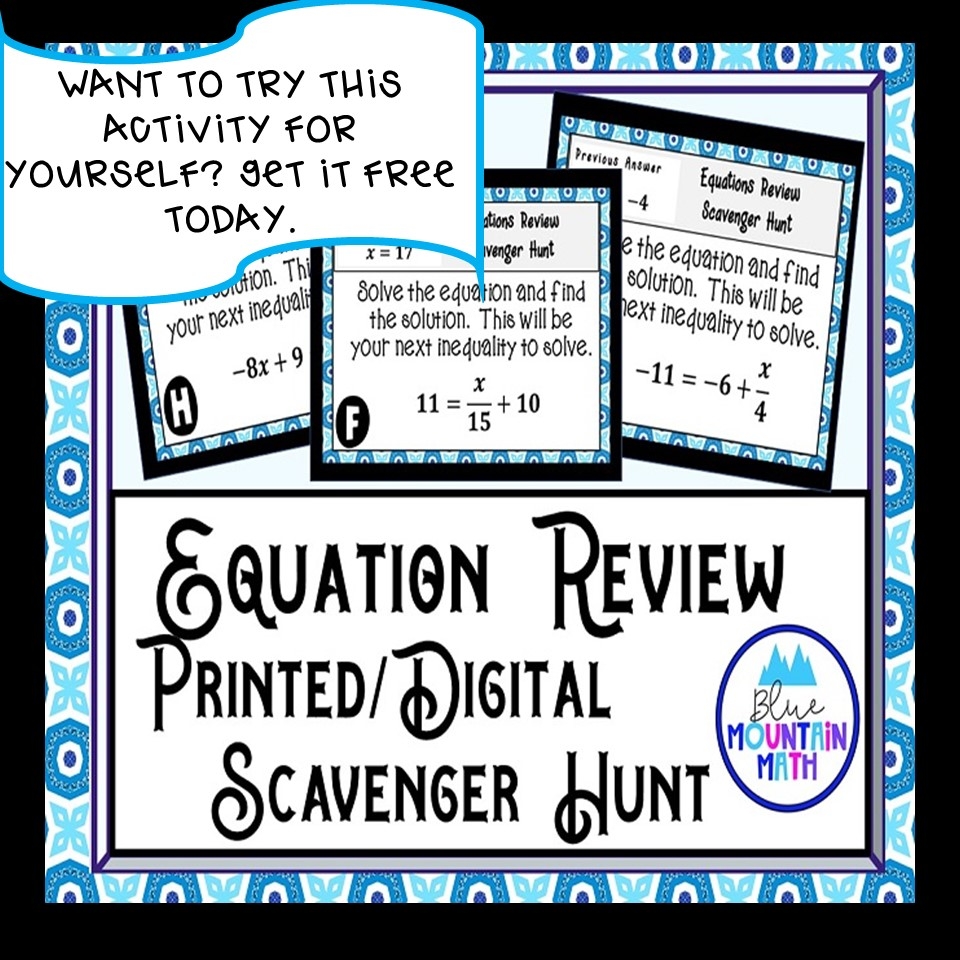Looking for way to get students moving, talking and learning all while having fun? Scavenger Hunts AKA Treasure Hunts is one of my go-to activities in the classroom.

Students love working with others, but I have found that they do not like group structures. Some students are happy working in pairs, some like trios, others like fours. A few students can navigate between different size groups but the loose structure of scavenger hunts seems to appeal to students while supporting them with peers.

What are Scavenger Hunts?
They also may be known as Treasure Hunts and while I have used different types, they have the same formats in common.
- The teacher usually prints and hangs the problems around the room. The pages of problems also contain the answer to a previous problem. Note: I hang them in plastic sleeves so students do not write answers on the pages (yes, this has happened, one student wrote “this problem sucks because it’s too hard”).

- Students are given a recording sheet to show their work and keep track of the order they complete the problems.

- Students can begin anywhere. When I use the digital format, students begin with the problem labeled “A”. Some teachers use a timer so students don’t stand at any one problem very long. I allow students to move at their own pace, some are moving quicker than others but this doesn’t bother me.
- Students write the problem number/or answer of the problem where they begin on their answer sheet/recording sheet and then solve the problem.
- Students then search the room for their answer on another page. When they find it, that becomes the next problem to solve. If they do not find it, they know to check their work.

- Students solve and search until their final problem has the answer where they started.
Why Students Love Scavenger Hunts
Working With Friends
Kids love the freedom of working with people they know and like instead of teacher assigned groups. This means they are more likely to ask each other for help, offer an idea or risk making a mistake since they feel safe.
Walking and Talking
They enjoy walking around in class instead of being confined to a desk. When I taught in middle school students needed movement to focus in class. Middle school has seven periods of 45 minutes each school day and sitting at a desk is torture.
Right Answers Needed to Move On
Students have all the answers and understand if their answer is not on one of those posted pages, they made a mistake. Even when students have self-checking activities, they are not prevented from moving on if they have made a mistake. With Scavenger Hunts, they need a correct answer to progress.
A Sense of Accomplishment
If you have ever finished a task successfully, what a sense of satisfaction. This is what students feel when they are finished and get back to that starting point. They feel accomplished and successful.
Modeling the Activity
Whenever I do a new activity or one that we have not done in a while, I model how to begin. I stand at the first problem and show how to begin. I use a thinking out loud approach reading the problem and thinking about how I’m going to solve it.
Then I solve the problem and walk around looking for the answer on another page, stopping at other pages and remarking “no, this is not the answer I got, I need to keep looking”.
After I have done the first problem, students are ready to begin, but I keep a watchful eye if they get stuck or look lost.
Helpful Hints for a Successful Hunt
1. Students like to prenumber their recording sheet. When they see the first problem is “A”, they like to start labeling “B”, “C” and so forth before they begin instead of doing the problems in order. They get confused about this.
2. If there are 12 problems in the hunt, then students should not get back to the beginning until they have completed the other problems. If they get back to Problem A, for instance, then they have made a mistake along the way and need to check their work. Sometimes this means showing them where they may have gone wrong, and steering them to the right answer.
3. Some students are slow. They get lost, confused and it takes them longer to complete. This is one reason I started creating a digital version of the Scavenger Hunt. If students do not finish in class, they can be assigned the Google Form version for homework and turn it in.
Digital Versions of Scavenger Hunts
I have missed this classroom activity so I created a printable/digital resource that can be completed in this same way. The pages can be printed and used in the classroom as I have described. Or, the Google Form version can be assigned thru Google Classroom or other platforms where you share activities and completed virtually.

Even if you are in the classroom, having a digital option gives you some versatility. Students are absent and need a way to do an activity to keep up with the class. A digital option is perfect.

Want to try a free activity for Equation Review? You can see for yourself the engagement in the classroom. I have used this strategy as a review before an assessment and noted the improvement. Get the activity here: Free Digital/Printable Scavenger Hunt.
What Do Other Teachers Have To Save About Scavenger Hunts?
“Love doing scavenger hunts to break up the monotony.”
“A great resource especially for distant learning – to keep everyone engaged.”
“Very wonderful resource! Easy for me and my students to use! Was great resource for distant learning!”
Whether you are in the classroom, in the hybrid model or virtually teaching, try a scavenger hunt. You can even assign in breakout rooms so students have the collaboration. Let me know how it goes at [email protected].










Leave a Reply